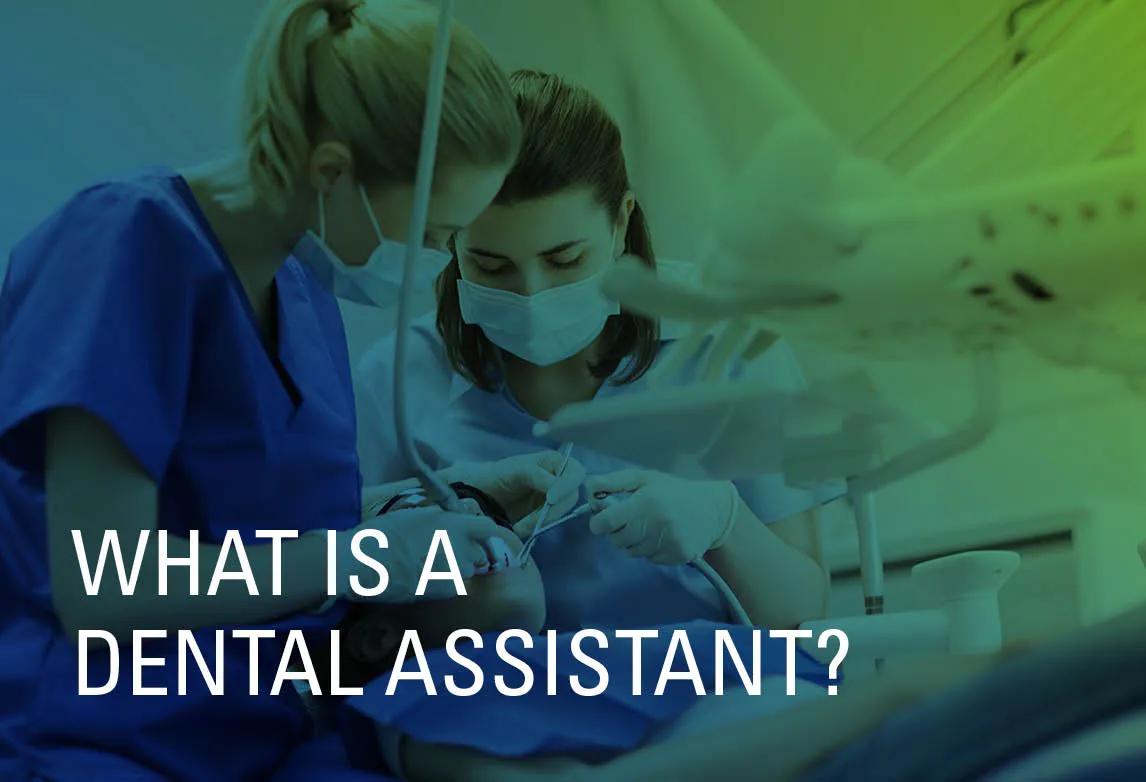What is a Dental Assistant?

Dental assistants provide patient care within dentist office settings. This care may involve preparing the patient or room for dental procedures, assisting licensed dentists while they work on patients, or performing administrative tasks such as scheduling appointments or updating patient records.
If you are interested in working as a dental assistant, you may be wondering what type of job responsibilities this position entails. We will provide that information, also explaining where dental assistants work and how to become one. And if you’re ready to start working toward a dental assistant career, we’ll talk about how you can do this as well.
What Does a Dental Assistant Do?
Dental assistants can have numerous job responsibilities. Depending on the employer, these responsibilities may include:
- Seating and preparing patients to see a dentist
- Sterilizing the equipment that will be used
- Assisting a licensed dentist during certain procedures, such as by handing them the necessary instruments or suctioning the patient’s mouth to keep it dry
- Performing administrative tasks such as scheduling the patient’s next appointment, updating their dental records, or assisting with billing
Some dental assistants are trained to perform a wider range of tasks. This is known as a dental assistant with expanded functions. Dental assistants with expanded functions can take x-rays, polish teeth, apply fluoride, create impressions, fabricate temporary restorations, remove sutures, and more.
Where Do Dental Assistants Work?
Dental assistants work primarily in dental offices.1 In this type of setting, they perform their duties under the supervision of a licensed dentist. You can also find dental assistants in laboratory facilities or working for companies that manufacture dental products or offer dental supplies.
Some dental assistants work a part-time schedule, although most individuals in this role are employed full-time.1 Depending on the employer’s hours of operation, a dental assistant’s schedule may require working days, evenings, or even some weekends.
The Bureau of Labor Statistics (BLS) indicates that dental assistant roles are projected to increase by 8% from 2021 to 2031.2 This rate is “faster than average for all occupations” and would equate to the addition of approximately 30,100 new dental assistant positions.
One of the reasons cited for this elevated level of growth is an aging population. Maintaining good oral health is important for older adults, in part, because chronic oral infection can spread to artificial joints (such as a replaced hip or knee) and endocardial implants.3
Plus, the number of adults over the age of 50 who are keeping their original teeth has increased from 14% to 21% between the time periods of 1999 to 2004 and 2009 to 2014, with complete tooth loss also declining between these periods, dropping from 17% to 11%.4 This suggests that this demographic will likely need continued oral care in their later years.
How to Become a Dental Assistant
The path to becoming a dental assistant can vary depending on the state in which you live and some employers. Some states require individuals working in these roles to complete an accredited educational program.5
Some states also require dental assistants and/or dental assistants with expanded functions to pass an examination. The Dental Assisting National Board (DANB) offers an exam that, once passed, provides the designation of Certified Dental Assistant (CDA). This exam consists of 255 questions which you have 195 minutes to complete, and you must have graduated from a CODA-accredited dental assistant program or have a high school diploma and more than 3,500 hours of work experience before you are eligible to take it.6 Other CDA exam eligibility requirements also apply, such as holding a valid CPR certification. Another examination is offered through American Medical Technologists (AMT) and leads to Registered Dental Assistant (RDA) certification. To qualify, you must have graduated from an accredited dental assistant program, hold a high school diploma, GED or equivalent combined with three years of experience, or have completed a military dental assistant training program combined with one year of work experience in this profession.7
You should check the state in which you would want to practice as a dental assistant to understand what requirements may apply.
Start Working Toward a Career as a Dental Assistant
If this sounds like a good career for you and you’d like to perform expanded functions, Ultimate Medical Academy (UMA) offers a Dental Assistant with Expanded Functions diploma program out of its campus in Clearwater, Florida. This program is a blend of online coursework and on-campus lab sessions and can be completed in 12 months.8 Topics covered include preventative dentistry, radiology, microbiology, and dental materials.
When you enroll in UMA’s Dental Assistant with Expanded Functions diploma program, you also have the opportunity to gain hands-on experience via a supervised externship. Upon completion of this program, you are prepared to sit for the RDA exam.
UMA is institutionally accredited by the Accrediting Bureau of Health Education Schools (ABHES.org) and has been providing healthcare education for more than 28 years, with more than 75,000 alumni. UMA’s Dental Assistant with Expanded Functions diploma program is approved by the Florida Board of Dentistry.
But what really sets UMA apart is that we make caring for our students a priority, enabling them to care for others. We do this by providing numerous student support services and connecting you with our employer partners once you’re ready to pursue job opportunities.
Learn more about what UMA can do for you. Your success is our goal, and we have several resources to help make this goal a reality!
1 Bureau of Labor Statistics. Occupational Outlook Handbook. Dental Assistants. Work Environment. https://www.bls.gov/ooh/healthcare/dental-assistants.htm#tab-3
2 Bureau of Labor Statistics. Occupational Outlook Handbook. Dental Assistants. Job Outlook. https://www.bls.gov/ooh/healthcare/dental-assistants.htm#tab-6
3 Coll P, Lindsay A, Meng J, et al. The Prevention of Infections in Older Adults: Oral Health. Journal of the American Geriatrics Society. https://doi.org/10.1111/jgs.16154
4 National Institute of Dental and Craniofacial Research. Older Americans are Keeping More of Their Teeth. https://www.nidcr.nih.gov/news-events/nidcr-news/2019/older-americans-are-keeping-more-their-teeth
5 Bureau of Labor Statistics. Occupational Outlook Handbook. Dental Assistants. How to Become a Dental Assistant. https://www.bls.gov/ooh/healthcare/dental-assistants.htm#tab-4
6 Dental Assisting National Board. Certified Dental Assistant. https://www.danb.org/exams/exam/cda-exam
7 American Medical Technologists. Dental Assistant (RDA). https://americanmedtech.org/Dental-Assistant
8 Completion time varies depending on the individual student.
Request Information
Talk with us. Start your journey.
Complete this form and we'll call you to explore options at UMA and answer your questions. We'll also email you info on how to get started. We're with you at every step!
Request Information
Talk with us. Start your journey.
Complete this form and we'll call you to explore options at UMA and answer your questions. We'll also email you info on how to get started. We're with you at every step!
About the Author
 Adam Fenster
Adam FensterAdam Fenster is a senior copywriter at Ultimate Medical Academy, with journalism experience from his time as a reporter and editor for multiple online and print publications. Adam has been covering healthcare education since 2019, with an emphasis on topics such as wellness, healthcare employment, and job preparedness. He received his BA in journalism from the University of South Florida.
Related Content


